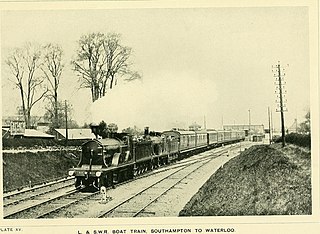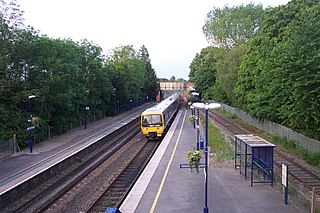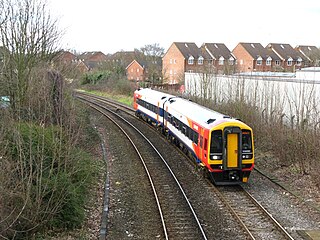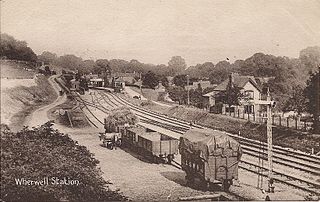History
This railway branch was completed as a double-track line in 1885. It was built by the London and South Western Railway in response to the planned Didcot, Newbury and Southampton Railway. The DN&SR, with the support of the L&SWR's rival the Great Western Railway, planned to build a main line route from the Midlands to Southampton in the heart of the L&SWR's territory, with its own terminus and an entirely separate line. The L&SWR was well aware that the DN&SR, like most start-up railway companies, was short of finances. It built 7.5-mile (12 km) Fullerton to Hurstbourne line to provide a complete line between Hurstbourne and Romsey. The L&SWR would offer the DN&SR the much cheaper alternative of building its line from Newbury to Hurstbourne, where its trains would then run on the new route along L&SWR track to the Southampton Terminus. The DN&SR would get its route to Southampton whilst the L&SWR would be able to exercise control over its competitor.
Since the Fullerton to Hurstbourne Line was intended to handle heavy freight and express passenger traffic from the Midlands via the DN&SR it was built with double tracks and large stations at Longparish and Wherwell complete with extensive goods yards. Despite the line's short length it included some substantial engineering, including a 50-foot (15.2m) deep cutting near Longparish.
In the event the DN&SR rejected the L&SWR's proposal and pushed on with its own independent route. Ironically construction of the line stalled for lack of funds at Winchester, but from there it was impossible to link with the Fullerton to Hurstbourne Line.
The L&SWR opened the Fullerton to Hurstbourne Line under its own operation on 1 July 1885 with three passenger trains a day operated by a locomotive and a single carriage shuttling between Fullerton and Whitchurch (the DN&SR had its own station at the latter village). By the 1890s the service had increased to 5 trains a day but the line remained lightly used. An attempt to reduce costs was made by introducing railmotors on the line in 1910. The line did serve a useful role as a diversionary route between Eastleigh and Southampton for special trains or during engineering works on the main line. Queen Victoria, attracted by the scenery surrounding the line, had the Royal Train sent down the line on several occasions when travelling between Windsor Castle and Osbourne House. It is rumoured that she preferred this route on the way to and from Osborne House because it did not involve passing through any tunnels.
By 1913 it was realised that the substantial investment put into building a line to main line standards would never be repaid on the light local traffic. The line was then reduced to a single-track line on 13 July 1913.
A saw mill near Longparish station employed more than 100 men between 1914 and 1919 and up to 30 wagons a day carried goods from the mill.
The passenger services was withdrawn on 6 July 1931.
During the Second World War, an ammunition storage depot was built near Longparish and the line handled a considerable amount of military traffic. The stores remained in place until the early 1950s.
The freight service last ran on 28 May 1956, but the track remained and was used to store condemned vans and wagons. The line was taken out of use in April 1960, although a short section at Fullerton remained until 1 June 1964.

The London and South Western Railway was a railway company in England from 1838 to 1922. Starting as the London and Southampton Railway, its network extended from London to Plymouth via Salisbury and Exeter, with branches to Ilfracombe and Padstow and via Southampton to Bournemouth and Weymouth. It also had many routes connecting towns in Hampshire and Berkshire, including Portsmouth and Reading. In the grouping of railways in 1923 the LSWR amalgamated with other railways to create the Southern Railway.

The Glasgow and South Western Railway (G&SWR) was a railway company in Scotland. It served a triangular area of south-west Scotland between Glasgow, Stranraer and Carlisle. It was formed on 28 October 1850 by the merger of two earlier railways, the Glasgow, Paisley, Kilmarnock and Ayr Railway and the Glasgow, Dumfries and Carlisle Railway. Already established in Ayrshire, it consolidated its position there and extended southwards, eventually reaching Stranraer. Its main business was mineral traffic, especially coal, and passengers, but its more southerly territory was very thinly populated and local traffic, passenger and goods, was limited, while operationally parts of its network were difficult.

The West of England line is a British railway line from Basingstoke, Hampshire, to Exeter St David's in Devon, England. Passenger services run between London Waterloo station and Exeter. Despite its historic title, it is not today's principal route from London to the West of England: Exeter and everywhere further west is reached more quickly from London Paddington via the Reading–Taunton line. At Salisbury, the line intersects with the Wessex Main Line.

The South Western Main Line (SWML) is a 143-mile major railway line between Waterloo station in central London and Weymouth on the south coast of England. A predominantly passenger line, it serves many commuter areas including suburbs of London such as around Hampton Court Palace and the conurbations based on Southampton and Bournemouth. It runs through the counties of Surrey, Hampshire and Dorset.

The West Coastway line is a railway line in England following closely the south coast of Sussex and Hampshire, between the cities of Brighton and Southampton. It has short southward branches to Littlehampton and Bognor Regis. Some trains using part of the route operate as direct continuations of passenger services to/from London, particularly those to the branch stations mentioned.

Aldermaston railway station serves the village of Aldermaston in Berkshire, England. The station is at nearby Aldermaston Wharf and about 2 miles (3 km) north of Aldermaston village. It is 44 miles 63 chains (72.08 km) measured from London Paddington.

Newbury railway station is located in the centre of Newbury, Berkshire, England, 53 miles 6 chains (85.42 km) from London Paddington. It is served by stopping services operated by Great Western Railway between Reading and Newbury and Bedwyn, and by many of its services between London Paddington and Exeter St Davids and other parts of Devon and Cornwall

Didcot Parkway is a railway station serving the town of Didcot in Oxfordshire, England. The station was opened as Didcot on 12 June 1844 and renamed Didcot Parkway on 29 July 1985 by British Rail to reflect its role as a park and ride railhead. It is 53 miles 10 chains (85.5 km) down the line from London Paddington and is situated between Cholsey to the east and Swindon to the west.

The Eastleigh–Romsey line is the railway line from Eastleigh to Romsey in Hampshire, England. At Eastleigh, trains join the South Western Main Line for onward travel to Southampton. At Romsey most trains terminate. The line is not electrified and all trains are diesel-powered.
The Didcot, Newbury and Southampton Railway (DN&SR) was a cross-country railway running north–south between Didcot, Newbury and Winchester. Its promoters intended an independent route to Southampton and envisaged heavy traffic from the Midlands and North of England to the port, but they ran out of funds to complete the line to Southampton. The intended heavy through traffic never materialised, and the line was dependent on larger railways—the Great Western Railway and the London and South Western Railway—for support, which was not freely given. The line opened in two stages, in 1882 and 1885.
The Largs Branch is a railway line in Scotland, serving communities on the north Ayrshire Coast, as well as the deep water ocean terminal at Hunterston. It branches from the Glasgow to Ayr line at Kilwinning.
The Sprat and Winkle Line was the common name of the Andover to Redbridge railway line which ran between Andover and Redbridge in Hampshire, England. It was built by the Andover and Redbridge Railway, which was incorporated in 1858. In 1863 the uncompleted railway was taken over by the London and South Western Railway (LSWR) who opened the line in 1865 and operated it until 1923 when the LSWR amalgamated with several other railways to create the Southern Railway (SR); in 1948 the SR itself amalgamated with other railways to form British Railways. The line was closed by the Beeching cuts in 1967.

The Reading–Basingstoke line is a short railway link between the South Western Main Line and the Great Western Main Line, constructed by the Great Western Railway between 1846 and 1848. The line is served by Great Western Railway local services between Reading and Basingstoke, which stop at the intermediate stations Reading West, Mortimer and Bramley. The line is also an important through route for longer distance passenger and freight services: CrossCountry services from Bournemouth and Southampton to Birmingham and the North of England and freight trains between Southampton Docks and the Midlands use the line. The section of line between Southcote Junction and Basingstoke was resignalled in 2006, to increase the capacity of the line.

Hurstbourne railway station served the village of Hurstbourne Priors in Hampshire, England. It was on the London and South Western Railway's West of England Main Line and was also the junction for the Fullerton to Hurstbourne Line, though trains for the Fullerton line started and stopped at Whitchurch, the next station to the east on the main line.

Whitchurch Town railway station was a station on the Didcot, Newbury and Southampton Railway in England. It served the town of Whitchurch, Hampshire, between 1885 and 1960.

The Chard branch lines were two lines serving the town of Chard in Somerset, England. One was a northward branch, opened in 1863, from the Salisbury to Exeter main line, and the other, opened in 1866, ran south-eastwards from the Bristol – Taunton main line. Each branch had its own Chard passenger station at first, although the two lines connected in Chard.
Northam railway station served the suburb of Northam in Southampton, England.

Fullerton Junction railway station served the village of Fullerton, Hampshire, England. It was on the Sprat and Winkle Line and the Fullerton to Hurstbourne Line.

Longparish railway station served the village of Longparish, Hampshire, England from 1885 to 1959 on the Fullerton to Hurstbourne Line.

Wherwell railway station served the village of Wherwell, Hampshire, England, from 1885 to 1956 on the Fullerton to Hurstbourne Line.
















